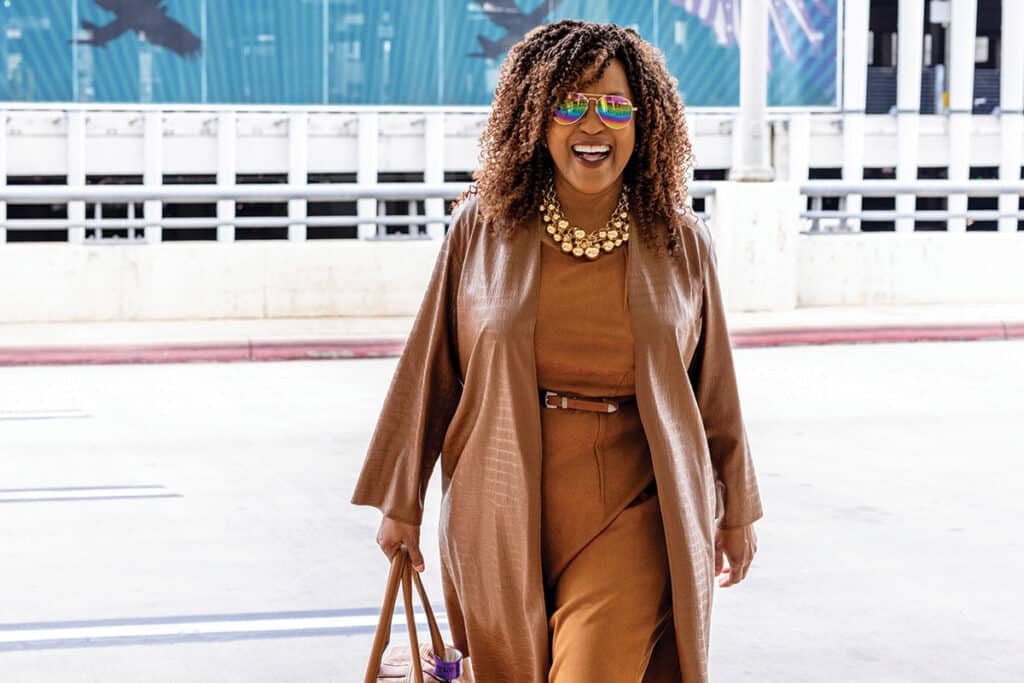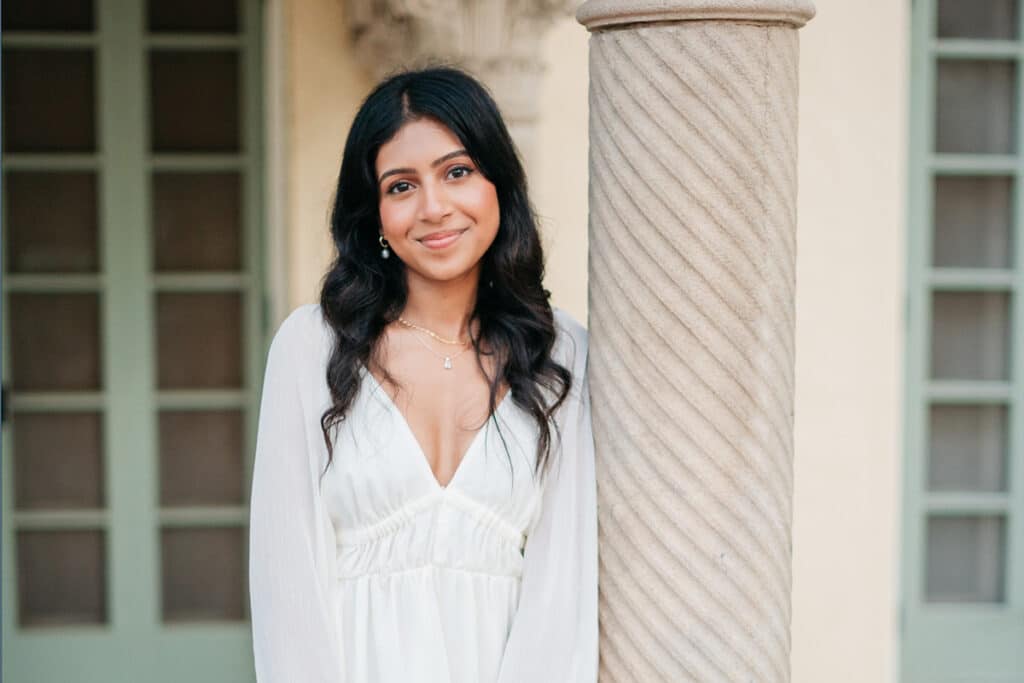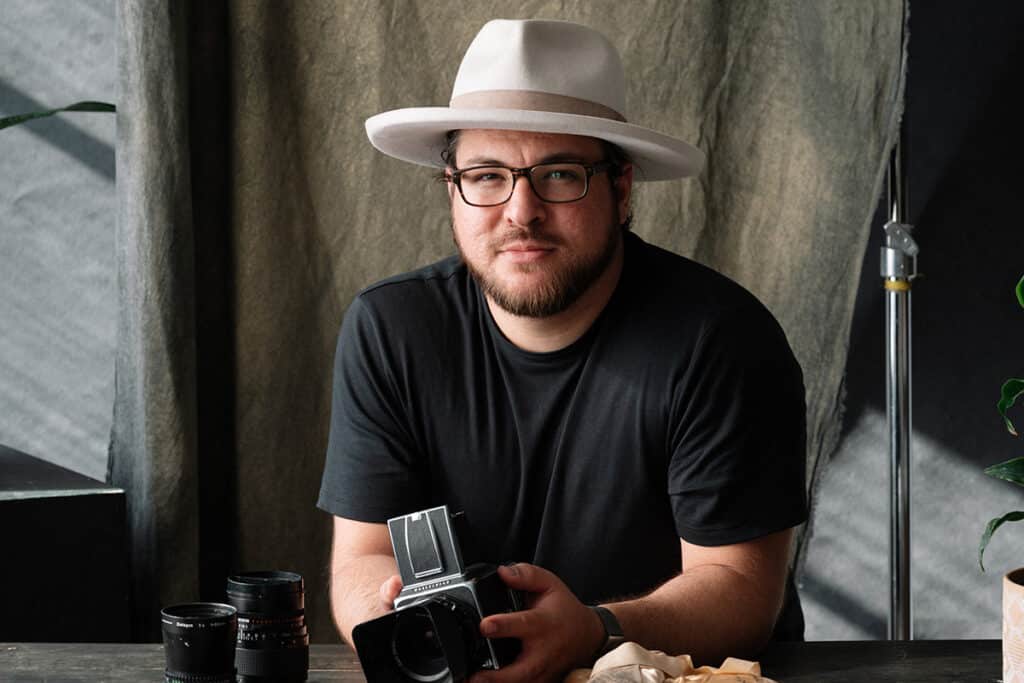Finding Success in the states
The word “immigrant” has traditionally been associated in this country with political refugees or impoverished “huddled masses yearning to breathe free,” but many newcomers since the 1960s do not fit either mold. Like the women we talked to for this article, they come for personal reasons, to advance their careers, explore new horizons or because of family ties. Often, they are very successful. Below are four such stories.
A sense of accomplishment
When Dr. Simona Cuevas was a little girl in Romania, her physician father went to a medical conference in Germany and decided to defect to the West. It took several years before his wife and children received the permission from the then-Communist authorities to join him. They had to abandon all their possessions as well as the comfortable life they had enjoyed in Bucharest as members of an established, well-known family. Her parents wanted to escape Communist repression, she explains, not poverty.
The family settled in Frankfurt, Germany, where both parents found employment as doctors (her mother is a cardiologist), and “life went on.” Though young Simona was artistically inclined, when it came to choosing a career, the choice was between medicine and dentistry. Her mother, who worked at the American Hospital in Frankfurt, became convinced that the United States offered the best medical training in the world, so her daughter was eventually dispatched to the University of Maryland in Baltimore to get an undergraduate degree.
“The first year there, I didn’t like it,” admits Dr. Cuevas, now an established cosmetic dentist in San Antonio. “I didn’t know anybody, and being suddenly alone in a new country, having to find an apartment, learning how to get around — these things were difficult. Also, the city was so big, the distances between, say, someone’s home and their grocery store, so vast.” With all the familial connections gone, it was also hard to accept that she was “a nobody” in this new country. “Nobody knows you, and they don’t care,” she notes. But it helped that she already knew English, and she eventually met the man who would become her first husband. The couple married in 1991 and moved to San Antonio, where Simona, then surnamed Maievschi-Schley, was accepted into UTHSCSA Dental School, one of the best in the country. Five years later, the determined young woman got a bank loan to open her own practice in the heart of the medical center. She credits her professor and mentor, Dr. Nasser Barghi, for giving her the necessary confidence to go into business by herself. Called the Institute of Esthetic Dentistry, the practice is housed in a small brownish building that stands out amid the large corporate-looking edifices in the area. There’s a comfy, intimate feel to the premises, with soft-colored artwork on the walls painted by the doctor herself. More colorful pieces by her 9-year-old daughter greet the visitors by the entrance to the waiting room. Clearly, both mother and daughter are gifted.
Dr. Cuevas is active in several dental organizations, lectures frequently at dental meetings and has served as contributing editor for the Journal of Cosmetic Dentistry. Today, both her mother and sister work at the dental office, the former as a bookkeeper and the latter as the office manager. “It’s fantastic, they are the biggest contributors to my success,” exclaims Dr. Cuevas. “In them I have a staff that has my best interests at heart; they are my biggest supporters.” Becoming a U.S. citizen was very meaningful for her “because it gave me a sense of belonging, of not being an outsider anymore.” She now lives with businessman Troy Gates, with whom she has a son. The kids have never visited Romania and do not speak the language, and their mom has never returned to her native country. Nevertheless, her former school friends from Bucharest, now spread around the globe, have found each other and keep in touch.
When she mentors dentistry students or potential students who sometimes shadow her for a day to observe the workings of a dental clinic, her advice is always the same: Make up your mind and make sure that you are willing to do the work necessary to get a diploma. If you work hard, you’ll succeed.
Asked how she felt about her own success in America, she turns thoughtful for a while. Then she says, “I don’t feel especially successful. I am comfortable, and I am happy that I can support my kids and send them to good schools. My biggest accomplishments are my children…” After a pause, she adds, “What gives me a sense of accomplishment is my patients’ trust in me. I have some very prominent patients, and it makes you feel good that you are appreciated by people you respect.”
Painting life anew
While Dr. Cuevas chose dentistry over art, Iranian-born Vida Tayari did the exact opposite. She abandoned medical studies in India and eventually embraced her talent and desire to study art. But the immediate reason for returning home was the start of the 1979 Islamic Revolution in her native country. As prominent landowners in their town, her father and brothers were arrested by the new theocratic government, turning the family’s life upside down for a while. (They were later released.) Yet leaving medicine behind was OK with young Vida since she had already discovered that “it wasn’t her favorite thing.” She soon married a man Dad chose for her and had a son, but as it turned out, marriage wasn’t her favorite thing either. “He was a good guy; we were just not compatible,” Tayari explains. Following her father’s death and a second unsatisfying union, the young woman found herself sinking into depression. To renew her spirits, Tayari turned to what she had loved best her whole life — painting. “I believe my father’s soul guided me to it,” she notes with emotion. “It really helped me; it actually saved my life.” A visitor to her far Northwest-side gallery in San Antonio can understand why. Her work ranges from detailed realistic renditions of nature, animals and people to a stunning abstract series of canvases titled 3D that indeed look three-dimensional. The most intriguing piece among the latter, Inner Universal, features a large red pyramidal structure, seemingly jutting out from the black background while a mysterious, suffused light churns in its depth. The artist explains that the light is the inner self, “the light of God inside us.” Her large realistic paintings are also works of devotion. “God has created so many beautiful things, I want to convey the beauty of his creation in my paintings,” she explains in her soft, halting English.
A recent immigrant – she arrived in 2008 – Tayari had no desire to leave Iran, where despite early setbacks, she had managed to move to Tehran and make a life for herself as a single mother of two boys. She studied art in earnest, eventually becoming teaching assistant to her teacher. From 1999 to 2008, Tayari ran her own teaching institute, opened a gallery in 2001, and exhibited her work both in her own and other Tehran galleries. Several magazines did stories on her. In 2005, she became the first recipient of the Superior Artist Award for Women given by the Persian Association of Knowledge and Art Observers. “Americans have the wrong idea about my country,“ she comments. “They think that we don’t have anything good there. We lived a normal, comfortable life. People are wise; they know how to live their lives to avoid trouble. Yes, women had to wear head scarves on the street, but otherwise they dress in modern and chic ways and are free to go wherever they want by themselves.” So life was going pretty well when her sister, Diana Malone, an orthodontist working in San Antonio, came to visit in 2006 and discovered Tayari’s artwork. “When she saw my paintings, she decided to apply for a visa and green card for me,” recalls the artist. “I never thought of leaving my country, but when she suggested it, I thought maybe I should take advantage of this opportunity.” In the end, she was granted a green card as one of 5,000 persons “of exceptional ability” in the arts and sciences that the Homeland Security Department allows annually.
However, only her younger minor son was permitted to come with her. Her firstborn is still in Iran. At 49, it wasn’t exactly easy to rebuild life and career in a foreign country, especially since her English was poor. “For a while, I was confused. Culture here is different,” she says. “There are so many rules and regulations to follow, so many different insurances to buy, taxes, registrations, etc.” But art helped her again. Even though she had to adapt to Texans’ taste and interests, when she paints, she forgets about everything else, slipping into a near-meditation mode. While not yet well connected with the local art community, Tayari has shown and sold her work at art fairs and other events in Tyler, Houston, Santa Fe, Fresno and Austin, and, of course, in her own aforementioned gallery. What she likes about Americans is that they guard their privacy and do not interfere much in each other’s lives. And they strive to enjoy life: “In some cultures people pride themselves on sacrificing for others, for living for other people. Here they live for themselves.”
If she had to do it all over, would she emigrate again? “That’s a hard question …” admits the artist, looking down with an uncomfortable laugh. “It doesn’t matter where you live. Happiness is a matter of inner peace. I have learned to be patient, to go with the flow.”
Hard work and Christian values
Many San Antonians have discovered the flavors of Korean cuisine thanks to Young Cacy, the chef and co-owner (with husband Thomas Cacy) of Ilsong Garden Korean Restaurant, located in a busy shopping center on Blanco Road, just inside Loop 410. Both the Express-News and the Current have bestowed accolades on the eatery over the years, proclaiming it “Best Korean” and “Best Asian Non-Chinese” restaurant several times. For the Korean-born Young it’s been a long road from her hometown of Teagu — where she was born during the Korean War — to her current life in San Antonio. As a young woman, Young liked fashion and dressmaking, so she studied design and worked organizing runway shows for a clothing manufacturer. But to make ends meet, she also took a weekend cashier job at the nearby American Air Force base. That’s where she met Tom, an American tech sergeant who swept her off her feet in a matter of months. In 1967, Tom took his bride to America to meet the family in Connecticut. Like Dr. Cuevas – and probably all immigrants — she admits to being “apprehensive about it, a new culture, language, people; it was a bit scary.” Her mother-in-law’s cool reception hardly helped. Before she knew it, however, she was following Tom from assignment to assignment, raising two sons and just coping the best she could.
“My first impression of America was that it was beautiful, more than I had imagined, but there were some shocking things, too,” she says. “When we went to North Carolina for our first assignment, we had to live in a trailer (there was a waiting period for base housing.) I had never seen people live in what looked like a railroad car. Tornadoes were another big shock. I had never seen anything like that before either.” Subtler cultural differences emerged as well. Americans tend to be less direct in speech than Koreans, for instance, and unwritten rules of hospitality and politeness are also different. Because of her husband’s long absences, Young was often a de facto single mother with little support from anyone. The couple couldn’t afford the airfare for her mother to come and help. Even long-distance phone calls were expensive back then, she points out. Then came a transfer to Korea, followed by six and a half years in Denver. That’s when Young finally got a chance to integrate herself in the community and find a job with a department store: “I enjoyed working very much. We Asians are hard workers. You know, in Korea, education used to be expensive. We paid to go to school and had to study hard. That’s why we are hard workers.” The family later moved to San Angelo and in 1995 to San Antonio, where Tom still works in the Civil Service. Along the way, the couple experienced a deepening of their faith in God, eventually identifying themselves as born-again Christians. “The Holy Spirit touched me in a special way in 1989. I became different and dedicated my life to God,” says Young. As a result, the Cacys became increasingly involved in the community and in supporting missionary work. Today, they are members of the All Nations Korean Baptist Church, where Tom also serves as the English-language associate pastor.
Thanks to previous experiences with cooking for fundraising events, Young felt confident that she could put her love of cooking to good use by opening a restaurant. It was a small place on Rittiman Road at first, but it started attracting the likes of chef/restaurateur Andrew Weissman, chef/author Scott Cohen, as well as the food critics. A few years later it relocated to the present, more central location. Korean cuisine is very healthy, she explains, as everything is either steamed or stir-fried, and vegetables play a big role. No MSG is used, and some vegetables are grown in the area specifically for Ilsong. “I am very proud to have introduced Korean food to San Antonio. Many people are familiar with Korean tech products but don’t know how great the cuisine is,” she comments. While she loves San Antonio, some of the changes she’s observed in the United States since her arrival decades ago trouble her. “It used to be that you could depend on people’s honesty and integrity. We’ve lost a lot of that. You can’t rely on people the same way,” she says. “People seem to try less hard in school, at work, in public life … Still, Americans should be more proud of being Americans. It’s still the best country in the world.”
After escape, a life of enterprise
Mariana Oliver was a young married businesswoman leading a comfortable life in Mexico City before her life changed, literally in a matter of days. When her father’s life was threatened by kidnappers back in 2002, the entire family, including her two siblings and her husband, left everything behind to escape to the United States on tourist visas. “It was a shock. Everything happened in seven days,” recalls Oliver, now a successful caterer/ restaurateur in San Antonio. “We fled the house, leaving everything in it, including Christmas gifts under the tree. We were in survival mode. It’s such a big step that if you think much about it, you may not take it, and then you may live to regret it.” The family spent a month in a San Antonio hotel before venturing back home to pack things up and settle their affairs. Her father later sold his large-scale food services company. Oliver grew up in and around her dad’s business in Mexico and later also worked there. All aspects of food preparation fascinated her. At some point, because she was thinking of starting her own catering enterprise, she enrolled in the Cordon Bleu culinary school in Mexico City to be better prepared for her future career. (She also holds a B.A. in business administration.) But the dream of sharing such a business with her husband, José Antonio Jauregui, lasted only about a year before they were pretty much forced into exile. Changing countries, however, did not diminish her love of cooking and baking. In 2008, the couple opened Marioli in the Stone Oak area, which Oliver envisioned as a gastronomic store where people would pick up gourmet meals to go. Perhaps because of unfamiliarity with the concept of upscale takeout, San Antonians responded poorly, compelling the owners to revise their ideas. Today, Marioli offers both dine-in and takeout options as well as a catering service.
Running a business in the U.S. can be both more difficult and easier than in Mexico, notes Oliver. “It’s harder because there are so many rules and regulations and also because the cost of labor is higher, and there’s so much competition,” she explains. “On the other hand, when you go to get your license, they tell you what documents you need and when you bring them in, you get your license. In Mexico, even if you have everything, they still make it difficult for you because they want you to pay them under the table. I like it here, because if you do what you are supposed to do, you’ll be fine.” Marioli’s catering customers include the Ruiz-Healy Gallery, the Mexican Cultural Institute, the McNay Art Museum, Trinity University and others. What Texans call Mexican food is not the food she grew up with in Mexico City. “Here, people think it’s all about enchiladas and tres leches cake, but that’s not the case in Mexico City,” she remarks. “There’s so much more. It’s a cosmopolitan city with a diverse culinary scene.” In fact, Mexican and French cuisines were recently designated as “intangible cultural heritage” treasures by UNESCO.
Moving to San Antonio did not require too much of an adjustment since Oliver already lived in the U.S. as a child and teen for several years, and her family used to come here on shopping trips. This month, she will have her citizenship interview with U.S. authorities, something she’s looking forward to with excitement. “I love the order here, I love that everything works the way it’s supposed to… We had a very comfortable life back home, and now we are working like crazy, but I have no regrets. I would rather live in the U.S. than in a bubble, afraid to go out, in Mexico.”








